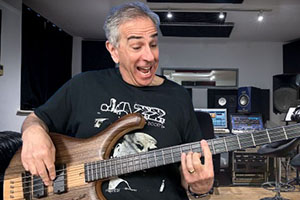Do this first – even if you don’t know what you’re playing!
By Jon Liebman
March 29, 2024
So you finally learned that cool bass line. It feels good, it sounds good, and you feel totally confident playing it.
YES!
But then you find out you learned it in the ‘wrong’ key. As it turns out, the band says they actually need to play it in some ‘weird’ key now (probably because of the singer).
Your heart sinks. All that time All that work. You’ve got the whole thing under your fingers. Now what?
No worries, my industrious groover. The bass is a very friendly instrument. It offers a familiarity unlike any other instrument, all the way up and down, from top to bottom.
Going after new skills
The key is in knowing how to take advantage of the consistency and the symmetry of the bass. That’ll help you get through rough spots like this. Granted, it’s on a mechanical level, before you’ve analyzed the actual musical part of what you’re playing. But hey, it’s a start. At least you’re playing it.
The subject came up during a recent conversation I had with Daniel Kimbro, a Tennessee-bred bassist/multi-instrumentalist who’s played with everyone from John Hiatt and Robben Ford to James Taylor and Eric Clapton – not to mention a whole lot of bluegrass!
During our conversation, published as this week’s FBPO interview, I asked Daniel what advice he has for someone who wants to play bass, particularly someone starting later in life.
Before he even got to the bass, he had some encouraging words for these folks, right off the bat.
“The first thing is have a vocation,” Daniel says. “It doesn’t matter when, and maybe it doesn’t matter so much what it is, but have a vocation. Have more than one. Go after things, go after new skills.”
“Shapes beget sounds”
As for the bass, he dialed right in to taking advantage of what I refer to as the ‘awesome consistency’ of the instrument.
“The thing that’s specific to bass,” he says, “is shapes beget sounds.”
He started to elaborate, first with examples of playing a root/fifth pattern and getting your fingers familiar with that particular shape.
“Those are the beginnings of a boxy shape that spell out of minor pentatonic,” he says, “which is the same thing as the major pentatonic but contextualized differently.”
The gift of the bass’s design
The beauty of the bass, I always say, is that in most cases, if you can play something anywhere on the bass, you can play it everywhere on the bass.
“You can start to see the bow kind of unravel,” Daniel says, “and you get to open this Christmas present where you get these sounds, first because of these shapes. And then you can start to analyze them and understand how they work.”
Try playing a pattern, any pattern. Then make note of the configurations, the “shapes” in which your fingers are moving. Now play that shape on another part of the fingerboard, in another range, another key.
No other instrument has that kind of consistency like the bass has. Some instruments, like guitar, come close, but nothing is 100% symmetrical like the bass, all the way up and down. It’s like magic!
If you can play it here, you can play it there
That shape you’re playing will work with any scale, any pattern, any lick. Start with the root/fifth patterns till you get used to the idea. Then take it from there, one pattern at a time, at your own pace.
“That root/fifth or root/fourth, or that fourth back to the tonic relationship,” Daniel says, “it’s so crucial to understand for a bass player because you you’re probably called to play on those pitches a lot during your bass line execution.”
That’s an understatement, for sure.
Regardless of whether it’s root/fifth or anything else, once you learn a pattern, a scale, a lick… anything, learning the shapes and playing them on other areas of the bass will expand your proficiency on the instrument big time.
“Just thinking about them as shapes,” Daniel says, “and not worrying about what notes you might be (playing) or what chords you might be spelling, I think it’s perfectly okay to think about shapes as they relate to the sounds. That’s a very quick way to get some things under your fingers.”
What about you?
Have you ever learned something on one area of the bass and then found yourself struggling to play it on a different part of the instrument? Try memorizing the shapes of the patterns you’re playing and then playing them somewhere else on the instrument. You’ll see a whole new world unfolding before your eyes – and your ears. Let me know how you make out. Leave a comment below and share your story. And be sure to watch my interview with Daniel here.


Thanks again for having me Jon. Appreciate it!
You’re welcome, Daniel. Thanks for a great interview!
Totally enjoyed Daniel’s interview. He makes many points that are very rellevant, takes me back many years to music theory studies and early bass learning.
The shapes idea kinda takes you to a cool place, away from the disciplined study to a more imaginitive free form kind of thing that I hadn’t given much thought to here lately, but used a lot back in earlier times when playing with the guys in the band I was in.
We did no covers, we were all original music, and what Daniel is talking about here, was a method I used fairly regularly.
Thanks, Michael. So glad to hear Daniel’s interview resonated with you!
I’m echoing Michael’s point. My band does covers & originals, I have quite a bit of freedom on the original stuff. I have no formal training, been playing since ‘69. I’ve been using fourths & fifths, just didn’t know it. Nice interview, now have new stuff to check out & learn from.
Love it! Thanks, Joe.
As always thanks Jon for your insight personal and via you interviewing others.
You’re welcome, Larry. Thanks for the thanks! LOL
Some friends and I started a band early in 1965. None of us knew anything except the drummer and keyboard player. I played bass, or rather tried to. We played together for 5 years. I didn’t really play with anybody much until I started playing with some guys in a start-up Cowboy Church. I struggled a while until I learned the basics of the Nashville Number System. I’ve never looked back. If you’re playing a pattern in one key, it’s the same in any key. Great interview. Thanks.
Thanks, George! I’ve never heard of a “Cowboy Church,” but I’m glad you got something out of the interview. 🙂
Awesome interview. That whole “ anywhere on the Bass, everywhere on the Bass” ….Love it. I was doing some session work for a young musician and he was like…I want this like right here…I gave him that and then on the playback he is like….Did you change something??? I had . It worked.
Anyway great interview. Thanks!
Awesome, John! Thanks for sharing that story.